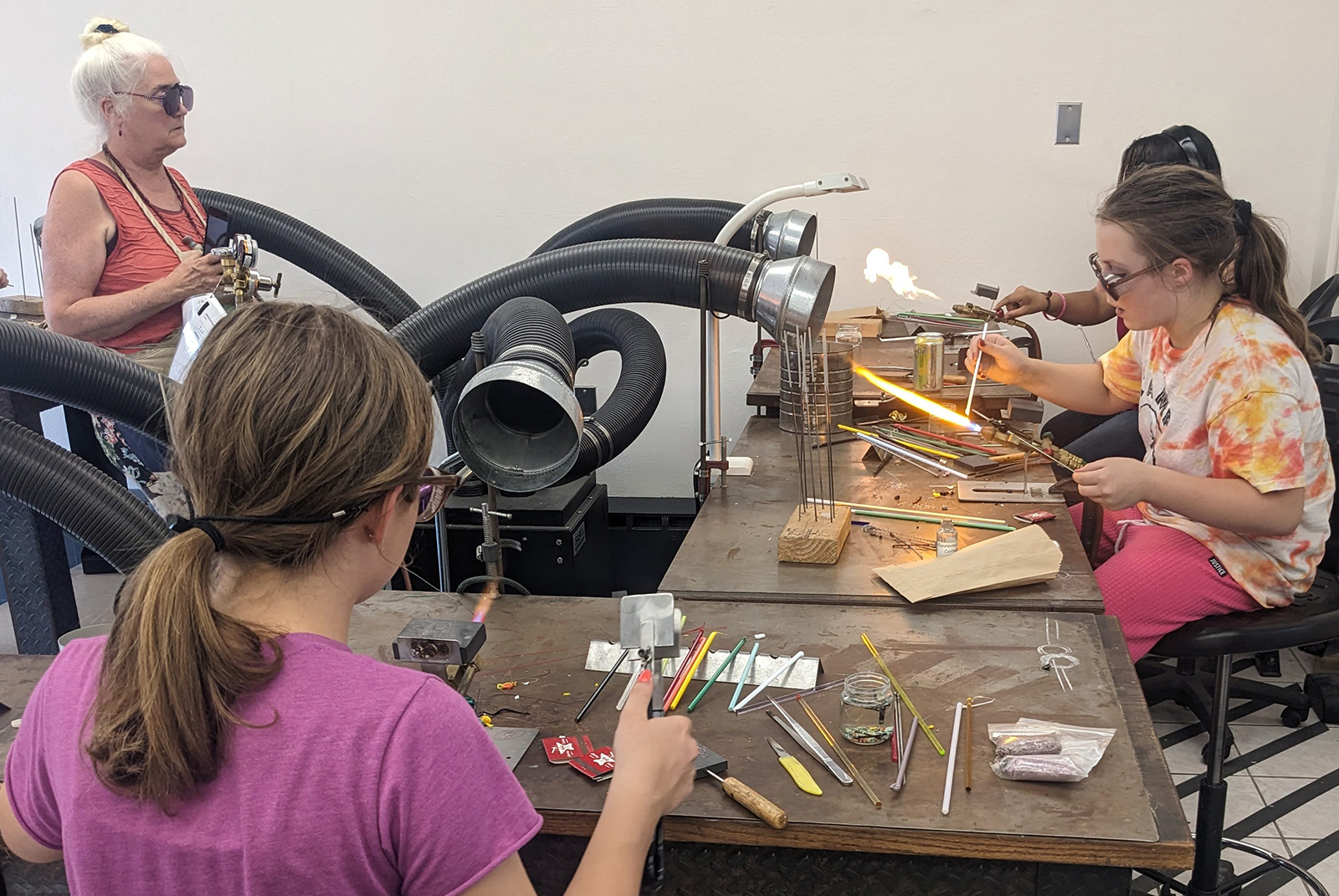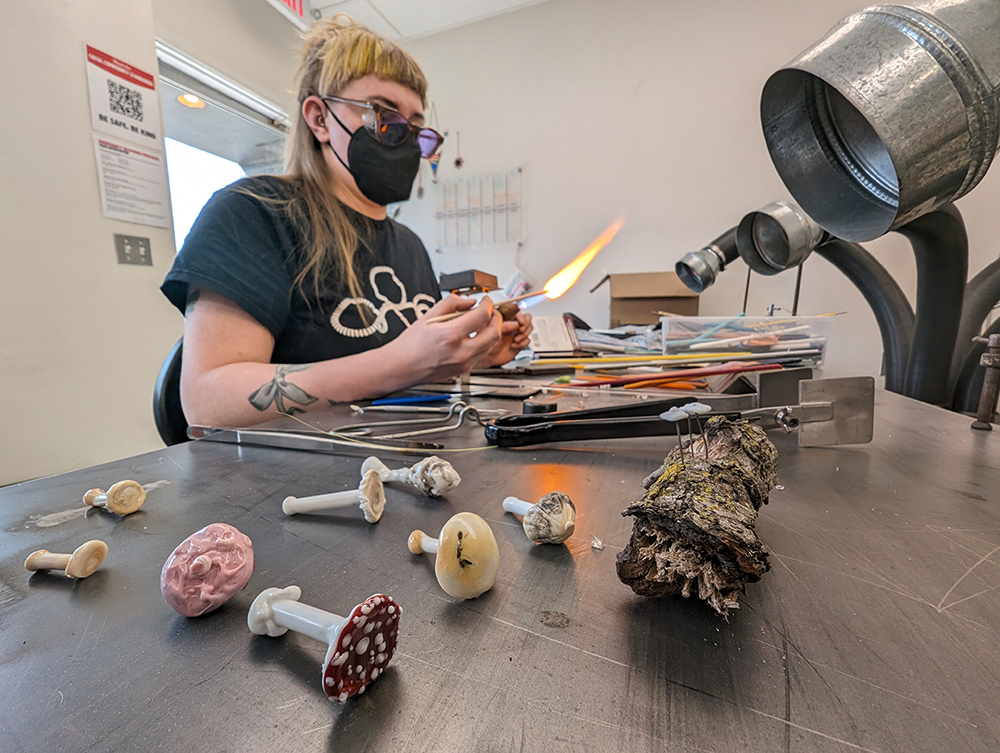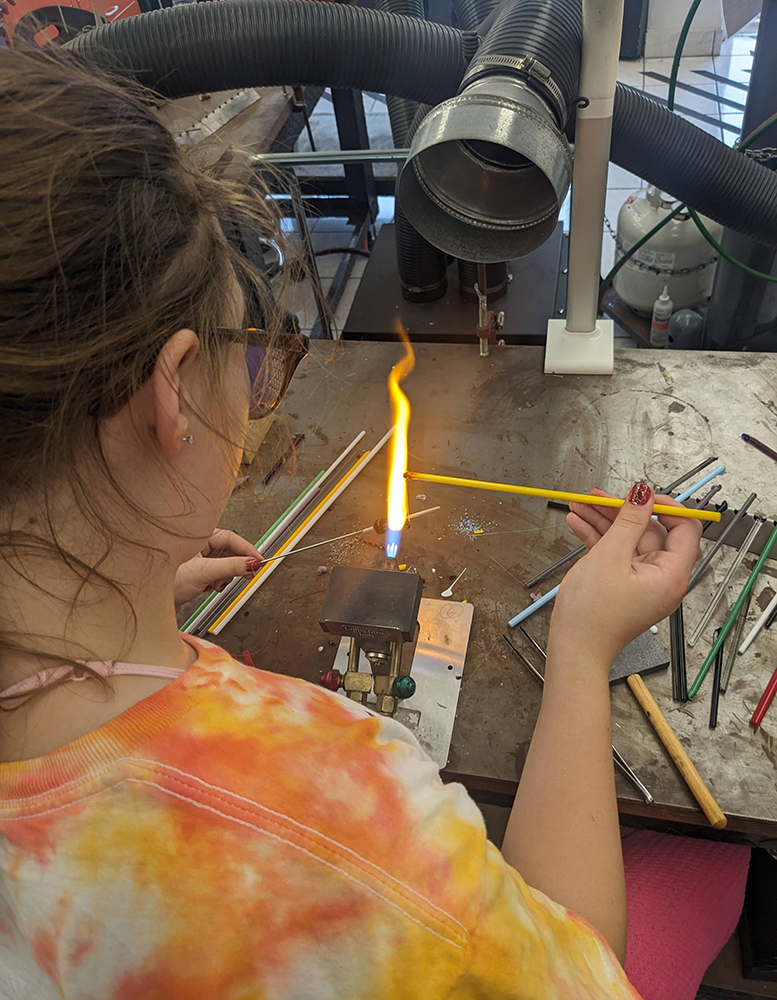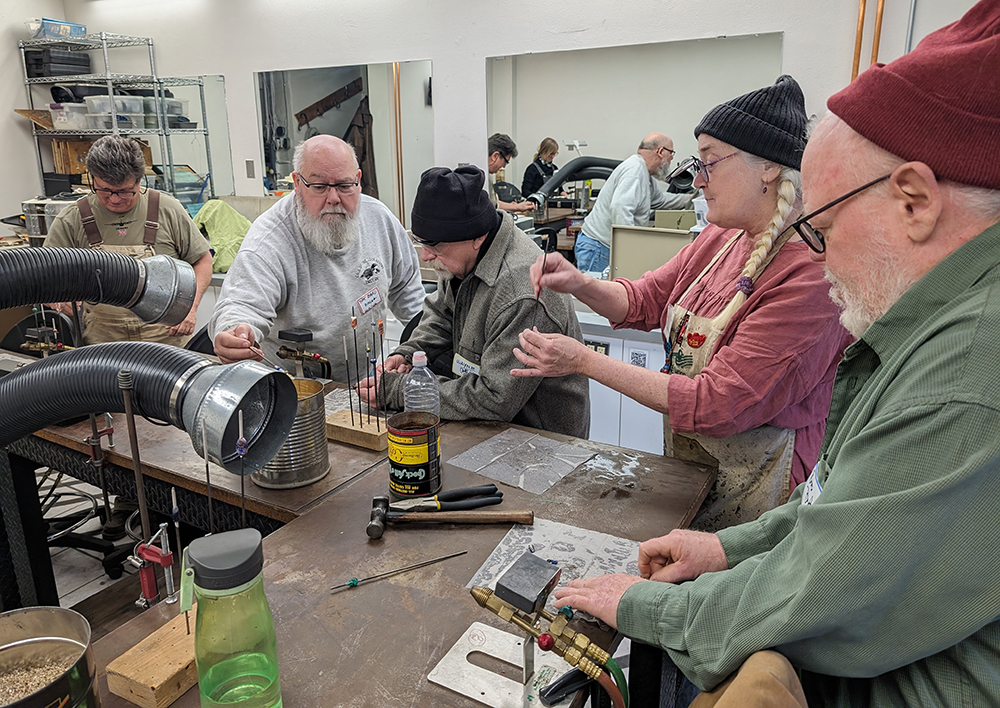
Two Model 400 Quad Arm Fume Extractors help protect students from art respiratory hazards while they use flames to change the shape of glass to create artwork, called flameworking.
The Chicago Ave. Fire Arts Center recently had an industrial hygiene report conducted by the Minnesota Department of Labor and Industry. The Chicago Ave. Fire Arts Center, in Minneapolis, Minnesota, is a non-profit organization that offers art classes that involve heat, spark, or flame (CAFAC). Due to the use of heat with metal or glass, fire art class activities produce harmful airborne particulate and fumes. This facility utilizes two Sentry Air Model 400 Quad Arm Fume Extractors to help protect students and faculty from exposure to harmful particulates and fumes, including iron, zinc oxide, copper, and others. According to the industrial hygiene report, most of the tested substances had an air concentration below the detection limit.
Classes at the Chicago Ave Fire Arts Center

A student at the Chicago Fire Arts Center using a flame to make small mushroom sculptures with the capture hose of the Model 400 Quad Fume extractor nearby to draw away fumes and particulate.
Blacksmithing
Enameling
Glass (Flameworking and Stained Glass)
Jewelry Making
Metal casting
Neon
Sculptural Welding
Fire Art Class Respiratory Hazards
Blacksmithing
Blacksmithing involves heating iron and other metals in a forge and using hammers and other tools to create the desired art form (CAFAC). Blacksmithing can expose students to metal dust, fumes, and smoke. Exposure to iron dust, fumes, or smoke can cause metal fume fever, which produces flu-like symptoms, and long-term exposure can cause siderosis (accumulation of iron in organs), leading to shortness of breath (New Jersey Department of Health and Senior Services, 2007).
Enameling
Enameling is the process of adding color to metal by fusing pigmented glass to metal at high temperatures (CAFAC). Similar to blacksmithing, enameling can produce metal dust and fumes. However, enamels can contain toxic metals such as cadmium, antimony, nickel, manganese, chromium, and cobalt, which can cause more long-lasting health side effects than iron. For example, chromium is very toxic and can cause scarring of the lungs (CDC 2019).

A student using a flame on glass tubes to change the shape into artwork near the capture hose of a Model 400 Quad Arm Fume Extractor.
Flameworking or lampworking uses a torch to melt or shape glass to create various objects such as beads or sculptures (The Crucible 2022). Flameworking can create a variety of respiratory hazards, including metal fumes, lead, and formaldehyde fumes (EPH-EHS).
Stained Glass
Stained glass work fuses colored glass using leaded came to create art. This process can expose operators to lead fumes. Lead exposure is dangerous, causing a wide array of health side effects, including abdominal pain, altered moods or depression, decreased lung function, and more (CDC 2024).
Jewelry Making
Jewelry making uses soldering to fuse metals together to create artwork. This process can produce similar respiratory hazards as stained glass if using a lead-based solder.
Metal Casting
Metal casting is the procedure of heating metal until molten and then pouring it into a mold to cool into the desired shape (CAFAC). Metal casting can produce metal fumes, leading to detrimental health side effects depending on the type of metal used.
Neon
Neon signage creation is similar to flameworking in that artwork is created by bending heated glass. Heating the glass can create fumes that can pose health side effects to the operator.
Sculptural Welding
Sculptural welding entails joining metal pieces using welding techniques to create art. This process produces metal fumes and particulate, causing different side effects depending on the type of metal.
Industrial Hygiene Report at Chicago Ave Fire Arts Center
To ensure compliance with Minnesota occupational work standards, the Minnesota Department of Labor and Industry conducted an industrial hygiene test at the Chicago Ave Fire Arts Center. The test measured the air concentration levels of certain substances to ensure that employee and student exposure was below the legal limit. The list below includes all the tested substances and their 8 hour time-weighed average exposure limit mandated by OSHA.
Butyl Acetate — 150 ppm
Hexane — 50 ppm
Methyl Amyl Ketone — 100 ppm
Methyl Ethyl Ketone — 200 ppm
Tetrachloroethylene — 25 ppm
Toluene — 100 ppm
Iron Fumes — 10 mg/m3
Zinc Oxide as fume — 5 mg/m3
Copper fumes — 0.1 mg/m3
Total Particulate — 10 mg/m3
For the test, organic vapor monitors were used to test the airborne solvent concentration and Gil air sampling for the metal dusts/fumes. The air concentration levels were collected over a 3 hour period on 5 different employees. Below are the results of each test. Each tested substance was below the detection limit, meaning almost no fumes or airborne contaminants could be measured, which is well below the legally required OSHA limit. The only substance that could be detected was total hexane VOCs. This substance does not have an OSHA PEL. It is the sum of all VOCs that aren’t detected as individual compounds due to a low quantity or concentration.
Table 1: 8-Hour Time-Weighted Average Solvent Air Sampling Results
| Air Concentration (ppm) at Each Employee | |||||
| Substance | Employee # 1: Mary | Employee # 2: Martha | Employee # 3: Sam | Employee # 4: Janis | Employee # 5: Heidi |
| Acetone | Bdl | Bdl | Bdl | Bdl | Bdl |
| Butyl Acetate | Bdl | Bdl | Bdl | Bdl | Bdl |
| Hexane | Bdl | Bdl | Bdl | Bdl | Bdl |
| Methyl Amyl Ketone | Bdl | Bdl | Bdl | Bdl | Bdl |
| Methyl Ethyl Ketone | Bdl | Bdl | Bdl | Bdl | Bdl |
| Tetrachloroethylene | Bdl | Bdl | Bdl | Bdl | Bdl |
| Toluene | Bdl | Bdl | Bdl | Bdl | Bdl |
| Total VOC Hexane Like | 2.3 | 2.1 | 2.3 | 2.1 | 1.8 |
Bdl = below detection limit
Table 2: Metal Exposures (mg/m3)
| Air Concentration (mg/m3) at Each Employee | |||||
| Substance | Employee # 1: Mary | Employee # 2: Martha | Employee # 3: Sam | Employee # 4: Janis | Employee # 5: Heidi |
| Total Particulate | Bdl | Bdl | Bdl | Bdl | Bdl |
| Iron Oxide | Bdl | Bdl | Bdl | Bdl | Bdl |
| Zinc Oxide | Bdl | Bdl | Bdl | Bdl | Bdl |
| Copper | Bdl | Bdl | Bdl | Bdl | Bdl |
Bdl = below detection limit
Engineering Controls at Chicago Ave Fire Arts Center

The Model 400 Quad Arm Fume Extractor has four self-supportive flex arms that can easily be maneuvered closer to the fume source.
Benefits of Model 400 Fume Extractor
• Variety of high quality filtration options – HEPA, ULPA, ASHRAE, Activated Carbon, and Specialty Blended filter media (ammonia, acid gas, and aldehyde)
• Single or dual filter configuration compatible
• Available with 1, 2, or 4 self-supportive capture arms
• Constructed of all flame-retardant materials – capture hose and filter (media and glue)
• Made in the USA
• Expert support available
Are you concerned about airborne contaminants in your facility? Contact us today to learn about fume extraction solutions to get your facility ready for an industrial hygiene report.
Call us today – 1.800.799.4609
Related Blogs:
• Fume Extraction for Jewelry Makers – https://www.sentryair.com/blog/industry-applications/soldering/fume-extraction-for-jewelry-makers/
• New artist friend from Adorn Me! liked using our fume extractors in her class – https://www.sentryair.com/blog/industry-applications/soldering/new-artist-friend-from-adorn-me-liked-using-our-fume-extractors-in-her-class/
• Making Art Can Make You Sick – https://www.sentryair.com/blog/industry-applications/chemical-solvents/making-art-can-make-you-sick/
References
CAFAC. Classes — Chicago Avenue Fire Arts Center. (n.d.). Chicago Avenue Fire Arts Center. https://www.cafac.org/classes.
CDC. (2019, Oct 30). NIOSH Pocket Guide to Chemical Hazards – Chromium metal. https://www.cdc.gov/niosh/npg/npgd0141.html
CDC. (2024, April 11). Symptoms of lead exposure. Lead in the Workplace. https://www.cdc.gov/niosh/lead/signs-symptoms/
EPH-EHS–Environmental Health and Safety–4400. (n.d.). Glassworking. Washington State Department of Health. https://doh.wa.gov/community-and-environment/contaminants/art-hazards/glassworking
The Crucible. (2022, March 28). Lampworking 101: Guide to Glass Lampworking & Flameworking. https://www.thecrucible.org/guides/lampworking-flameworking/
New Jersey Department of Health and Senior Services. (2007). Iron oxide. https://nj.gov/health/eoh/rtkweb/documents/fs/1036.pdf

 Made in the USA
Made in the USA



